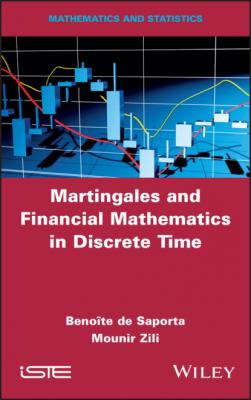Martingales and Financial Mathematics in Discrete Time. Benoîte de Saporta
Читать онлайн.| Название | Martingales and Financial Mathematics in Discrete Time |
|---|---|
| Автор произведения | Benoîte de Saporta |
| Жанр | Математика |
| Серия | |
| Издательство | Математика |
| Год выпуска | 0 |
| isbn | 9781119885023 |
207 201
208 202
209 203
210 204
211 205
212 206
213 207
214 208
215 209
216 210
217 211
218 212
219 213
220 214
221 215
222 216
Series EditorNikolaos Limnios
Martingales and Financial Mathematics in Discrete Time
Benoîte de Saporta
Mounir Zili
First published 2021 in Great Britain and the United States by ISTE Ltd and John Wiley & Sons, Inc.
Apart from any fair dealing for the purposes of research or private study, or criticism or review, as permitted under the Copyright, Designs and Patents Act 1988, this publication may only be reproduced, stored or transmitted, in any form or by any means, with the prior permission in writing of the publishers, or in the case of reprographic reproduction in accordance with the terms and licenses issued by the CLA. Enquiries concerning reproduction outside these terms should be sent to the publishers at the undermentioned address:
ISTE Ltd
27-37 St George’s Road
London SW19 4EU
UK
John Wiley & Sons, Inc.
111 River Street
Hoboken, NJ 07030
USA
© ISTE Ltd 2021
The rights of Benoîte de Saporta and Mounir Zili to be identified as the authors of this work have been asserted by them in accordance with the Copyright, Designs and Patents Act 1988.
Library of Congress Control Number: 2021944040
British Library Cataloguing-in-Publication Data
A CIP record for this book is available from the British Library
ISBN 978-1-78630-669-2
Preface
The authors owe a lot to many people and institutions who have contributed in diverse ways to this book. Most of the material presented in this book was used in various courses at different levels and for different audiences, being constantly amended and improved based on the feedback received from colleagues and students.
About half of these chapters were initially designed for students studying Financial Engineering as part of their MIMSE master’s program (Engineering Mathematics, Statistics and Economics), created in 2007 and jointly offered by the Universities of Bordeaux 1, Bordeaux 2 and Montesquieu Bordeaux IV, which then merged to form the present-day University of Bordeaux. The students who took this course were awarded their bachelor’s either in economics or mathematics. Some parts of this course benefited from the experience of and collaboration with other professors such as François Dufour and Christine Marois.
Some chapters in this book are also the results of notes created by a group of teachers on stochastic processes, which were given to students, from 2013 onward, undergoing the course Mathematics and applications as part of their Research Masters under the Faculty of Science in the University of Monastir. In the framework of this stream, and following the initiative of Ali Gannoun and Leila Ben Abdelghani Bouraoui, the course material at Montpellier was also adapted in 2017 for another unit that taught Financial Mathematics in the Faculty of Science at Monastir.
Other chapters were first designed to be a part of the Stochastic Processes course in the Biostatistics and Mathematics of Information and Decision-Making streams in the Masters in Mathematics offered by the University of Montpellier.
The authors extend their warmest gratitude to all the people and institutions who have contributed to the creation of this book.
The authors wish to dedicate this work to Leila Ben Abdelghani Bouraoui and Ali Gannoun.
Benoîte DE SAPORTA
Mounir ZILI
August 2021
Introduction
Ever since the work of Black-Scholes-Merton [BLA 73] in 1973, the design, analysis and development of complex financial products and services have required not only an ever-greater understanding of financial theories but also a mastery of probability theory and stochastic processes.
This book introduces basic concepts of this theory, especially that of discrete-time martingales. It shows how this concept can be applied to the pricing and hedging of derivatives in financial markets. There are many texts in the existing literature that focus on financial mathematics and the evaluation of options, for example [LAM 97, SHR 04, VIN 04]. The majority of these texts consider only continuous-time models and make extensive use of Itô calculus. A few rare books such as [SHR 03] introduce discrete-time studies, but this is also done to prepare readers to understand continuous-time financial markets. The most unique feature of this book is that it is entirely devoted to discrete time and provides a detailed introduction to the construction of the rigorous mathematical tools required for the evaluation of options in financial markets. The only pre-requisite for this book is a basic understanding of probability. Several theoretical and numerical aspects are studied in this book, explored through multiple examples and exercises for which complete solutions are provided.
To the best of the authors’ knowledge, this book is the first reference to include both mathematical teaching with multiple exercises that have detailed solutions, focusing on discrete martingales and their application to financial markets, and practical work with solutions, using the software R. Special attention is paid to the Cox, Ross and Rubinstein model in discrete time.
This book is meant for students at the master’s or doctoral level who are specializing in applied mathematics or finance as well as teachers, researchers in the field of economics or actuarial science, professionals working in the various finance sectors, or any other person who may be interested in a rigorous and accessible mathematical construction of the tools and concepts used in financial mathematics or the application of the martingale theory in finance. Finally, the practical work on optimal portfolio management in Chapter 5, as well as the study of American options in Chapter 7, may serve as an elementary introduction to stochastic control problems.
